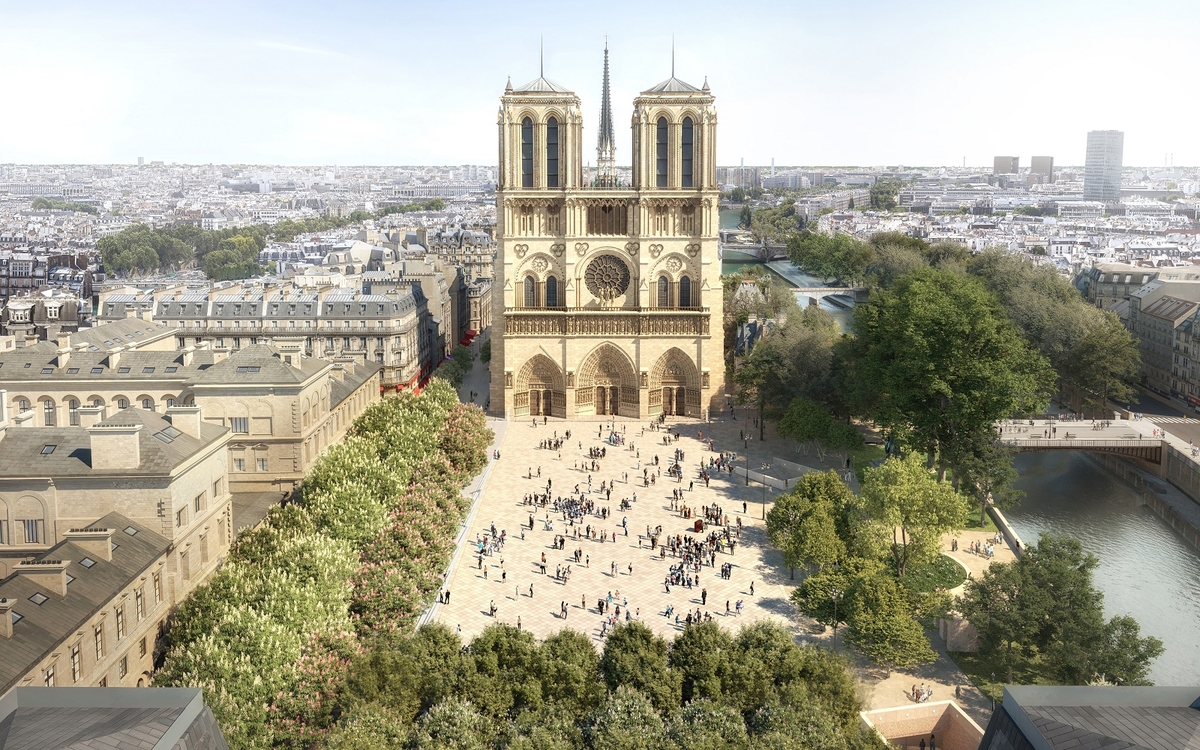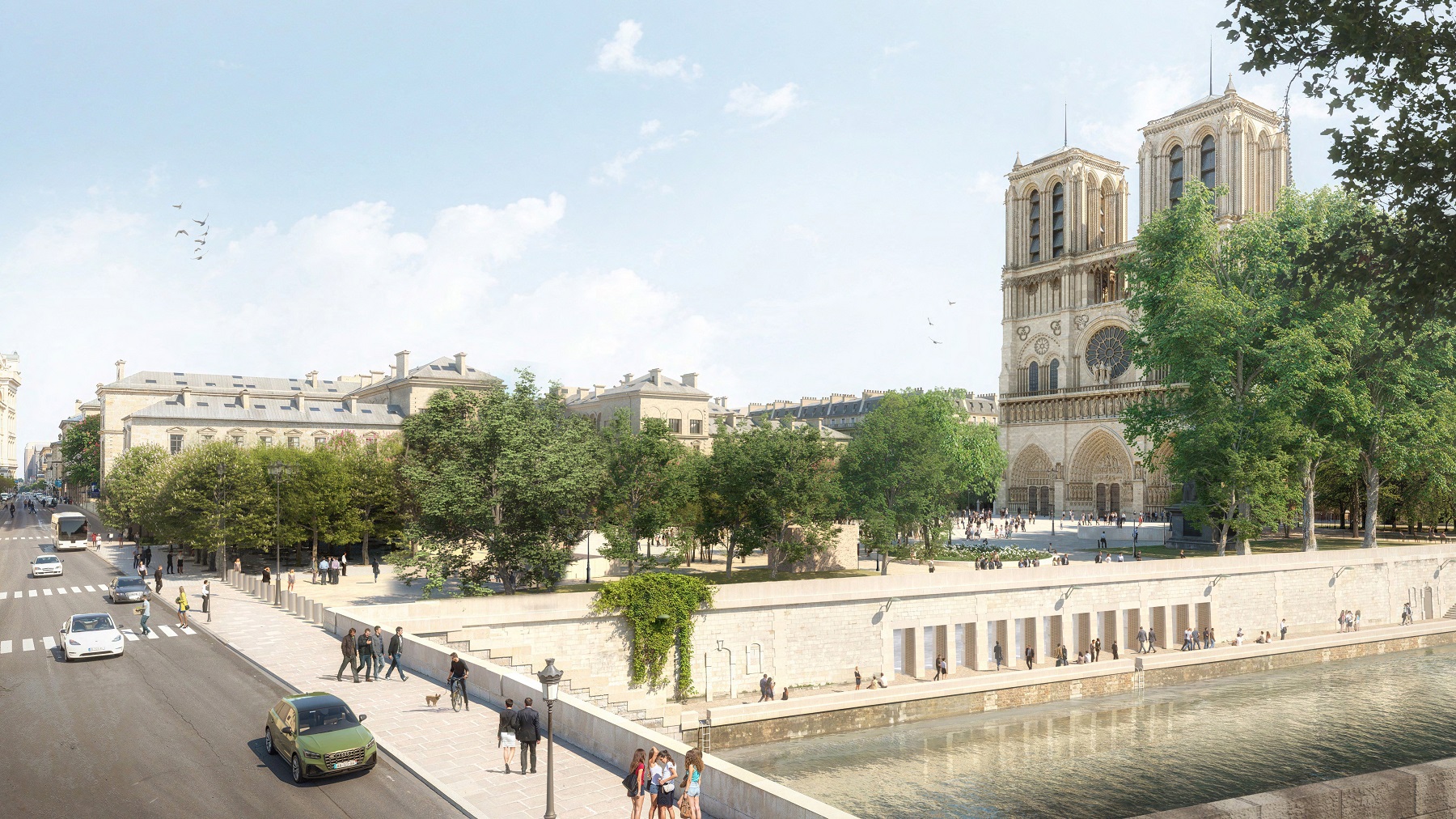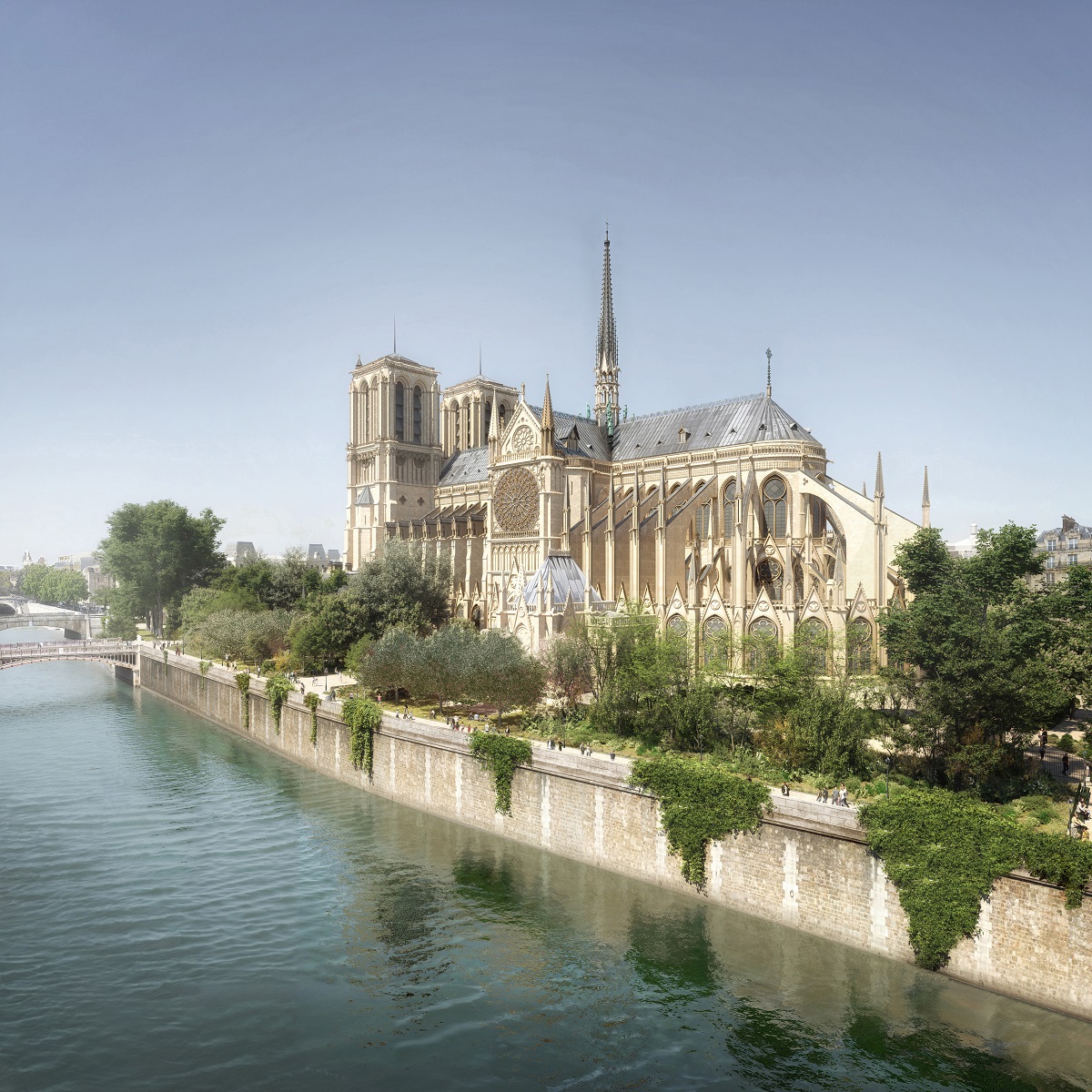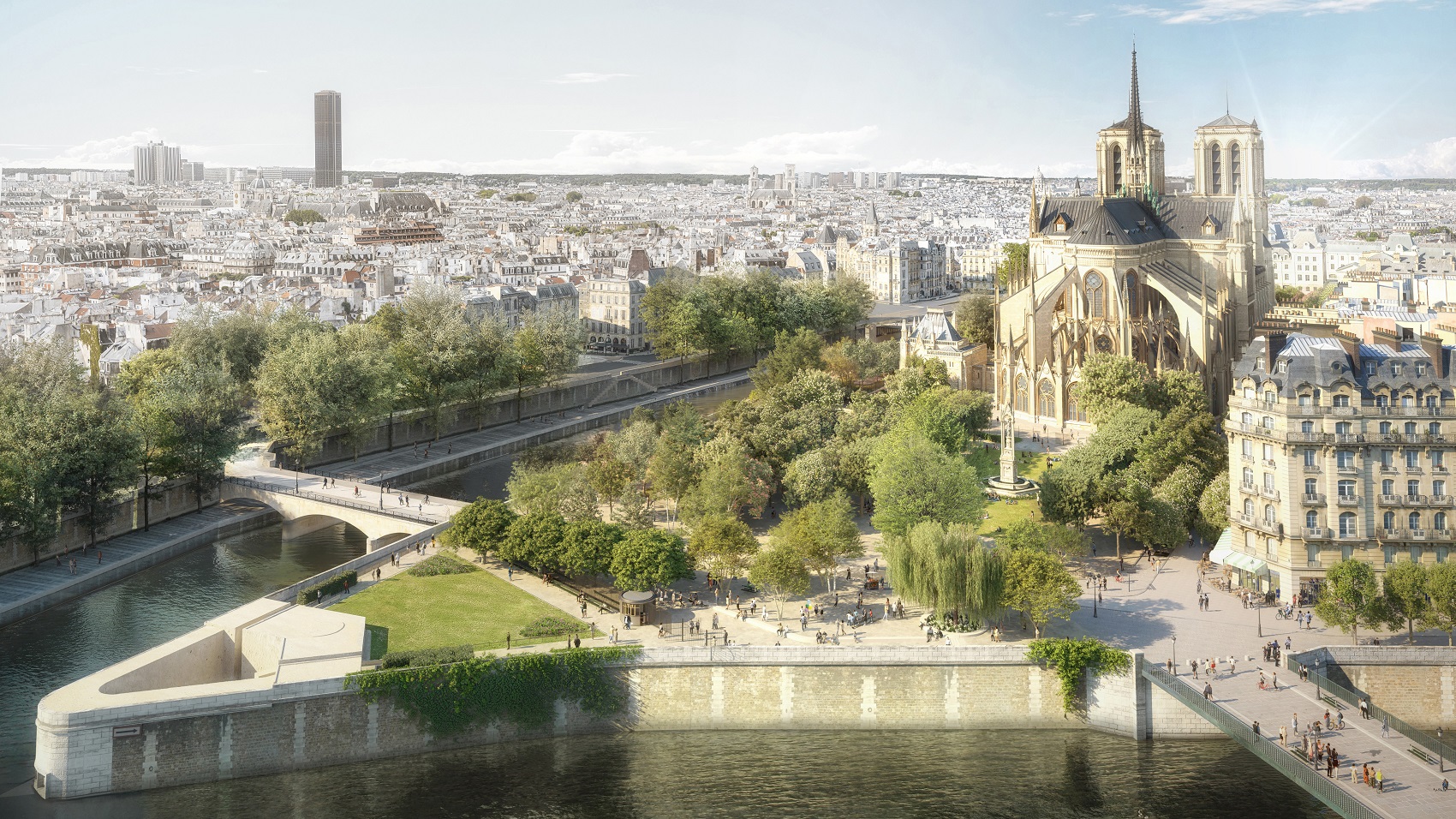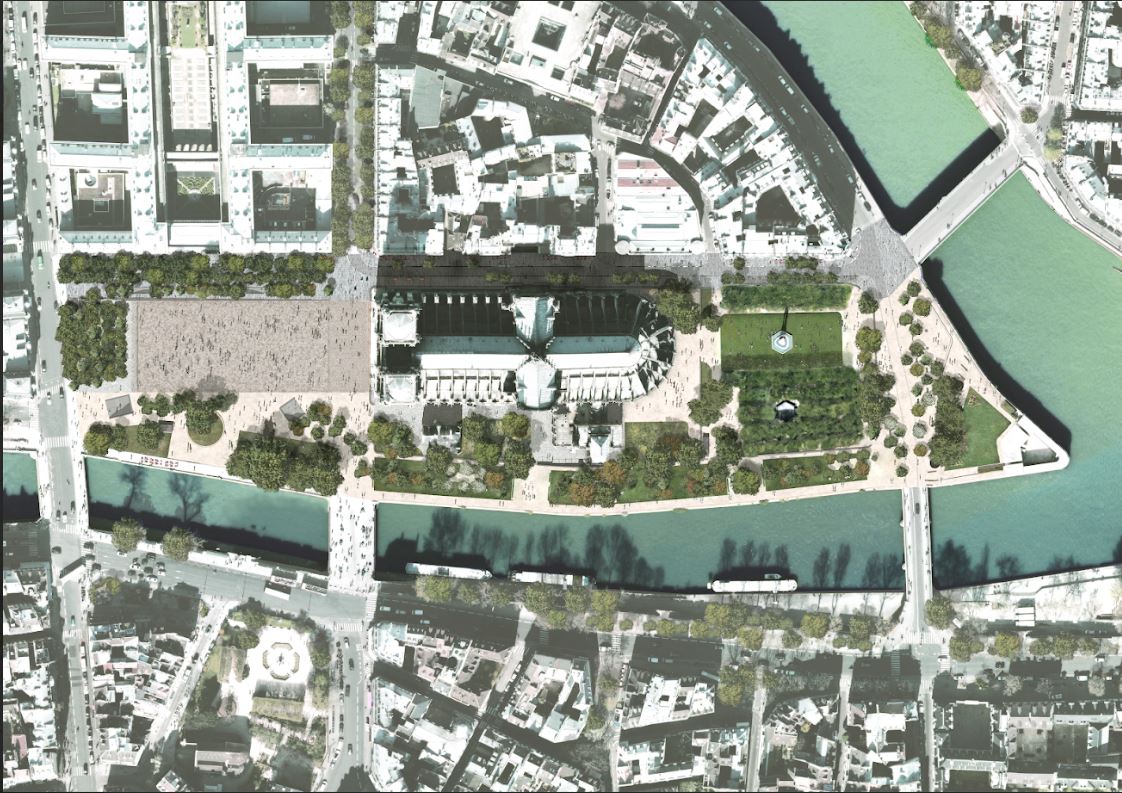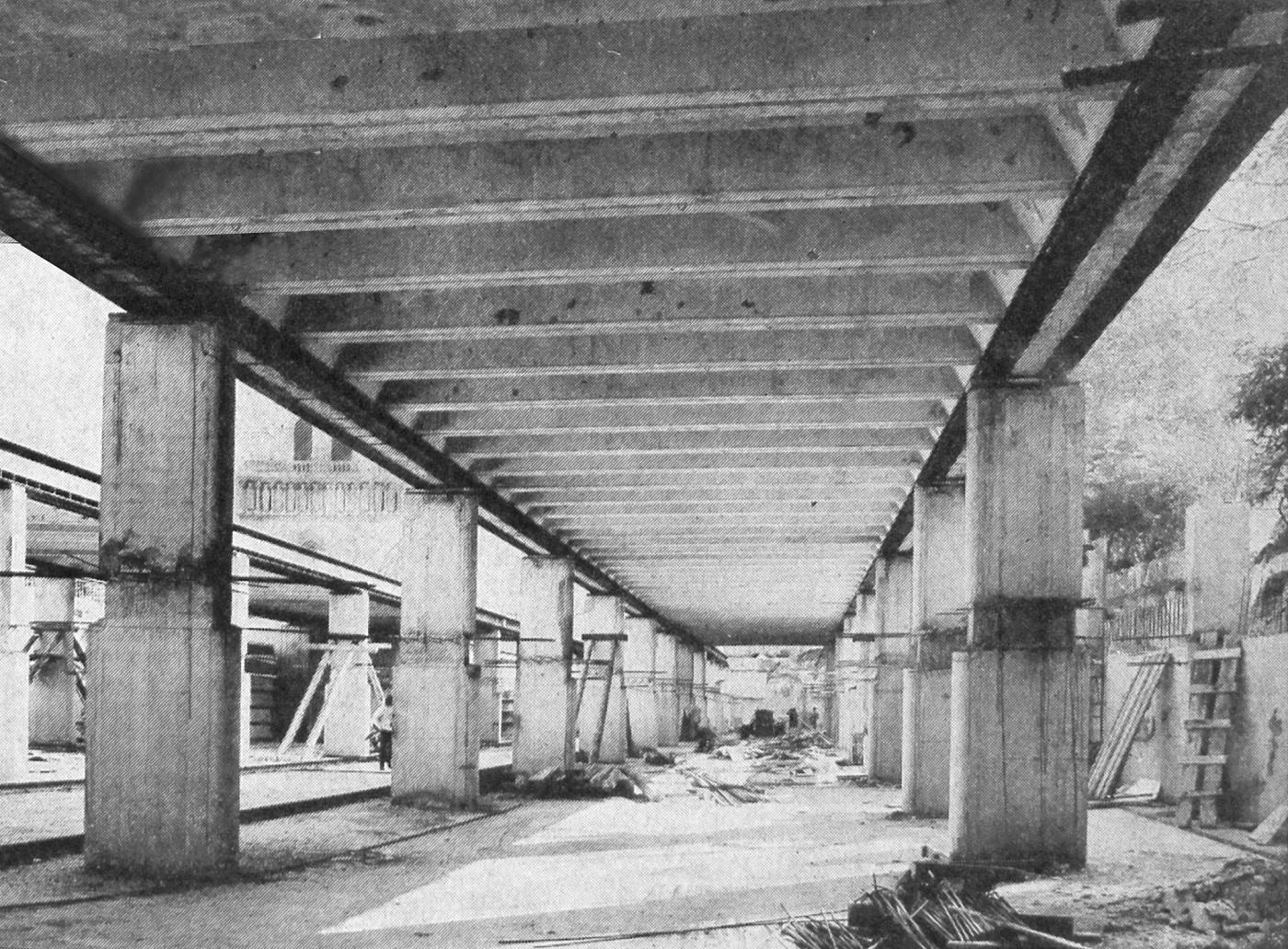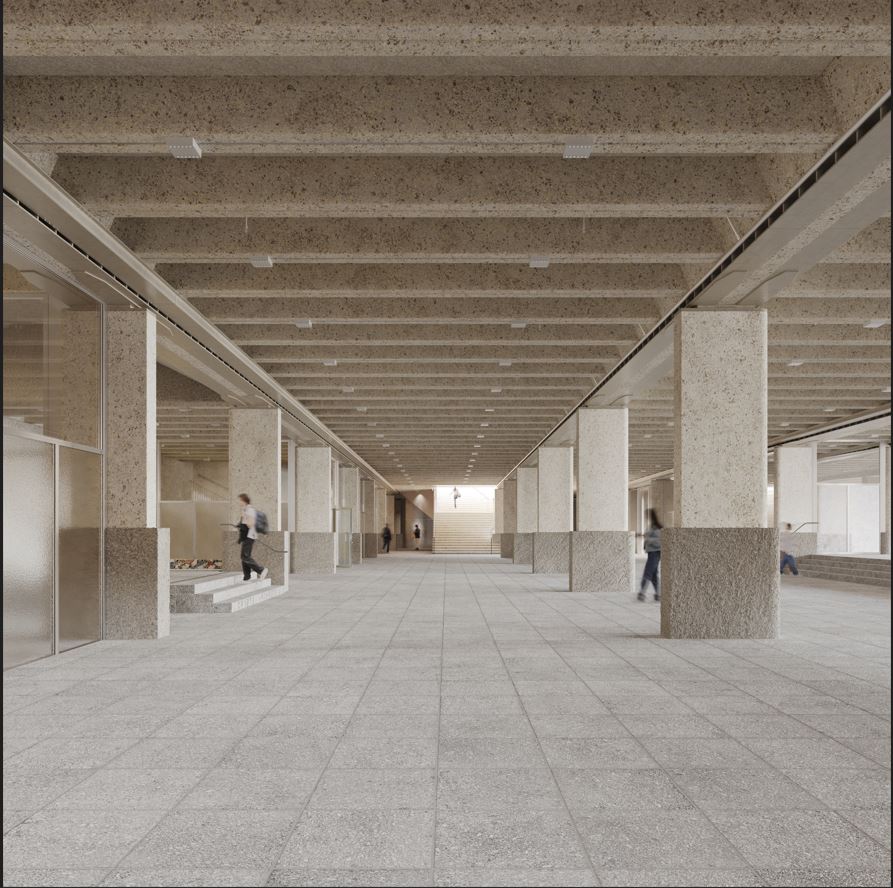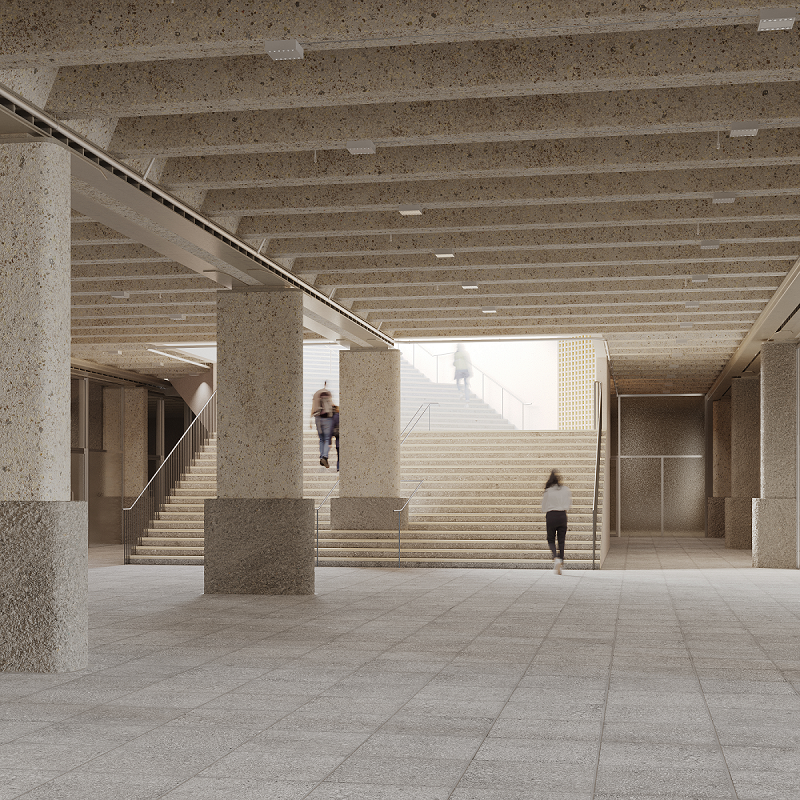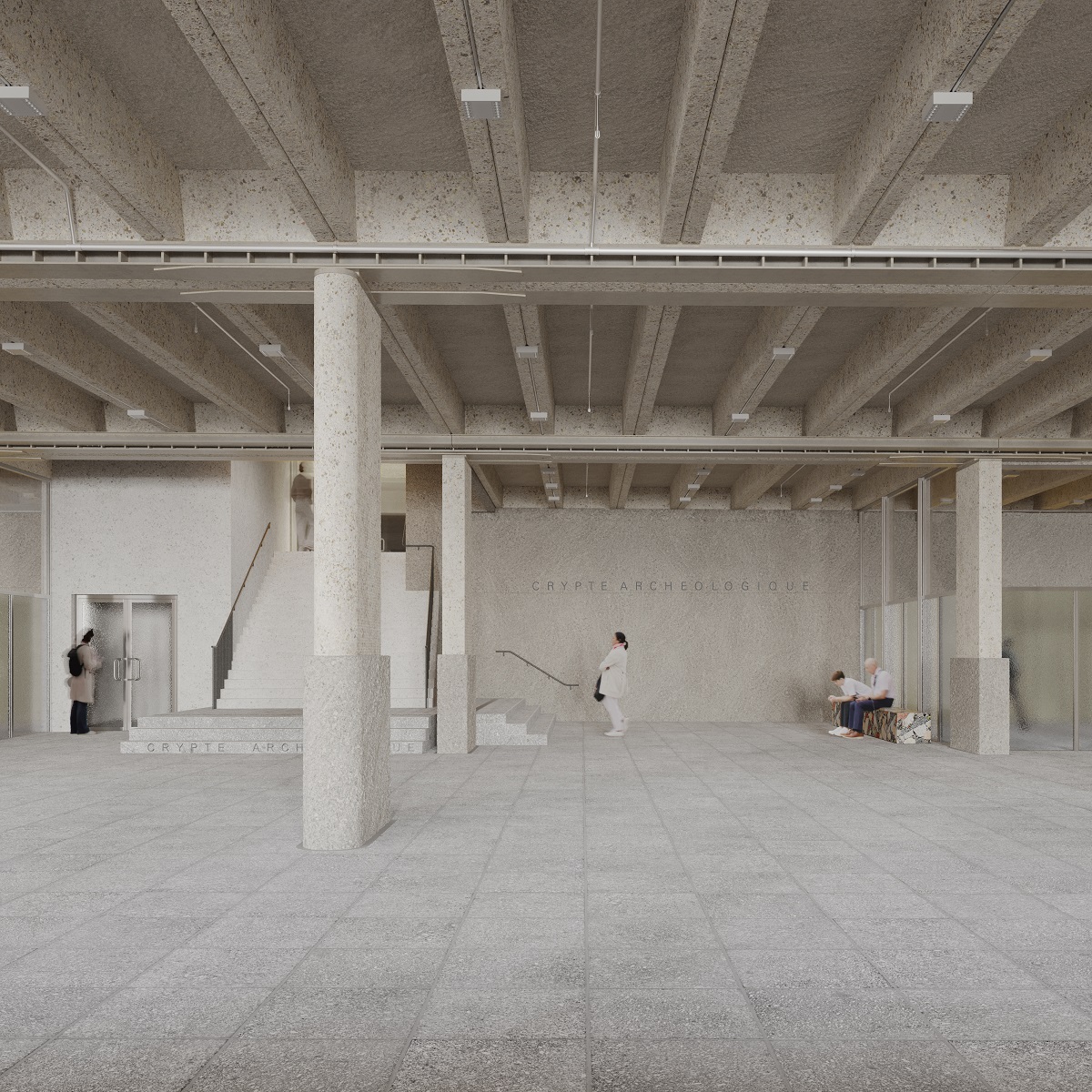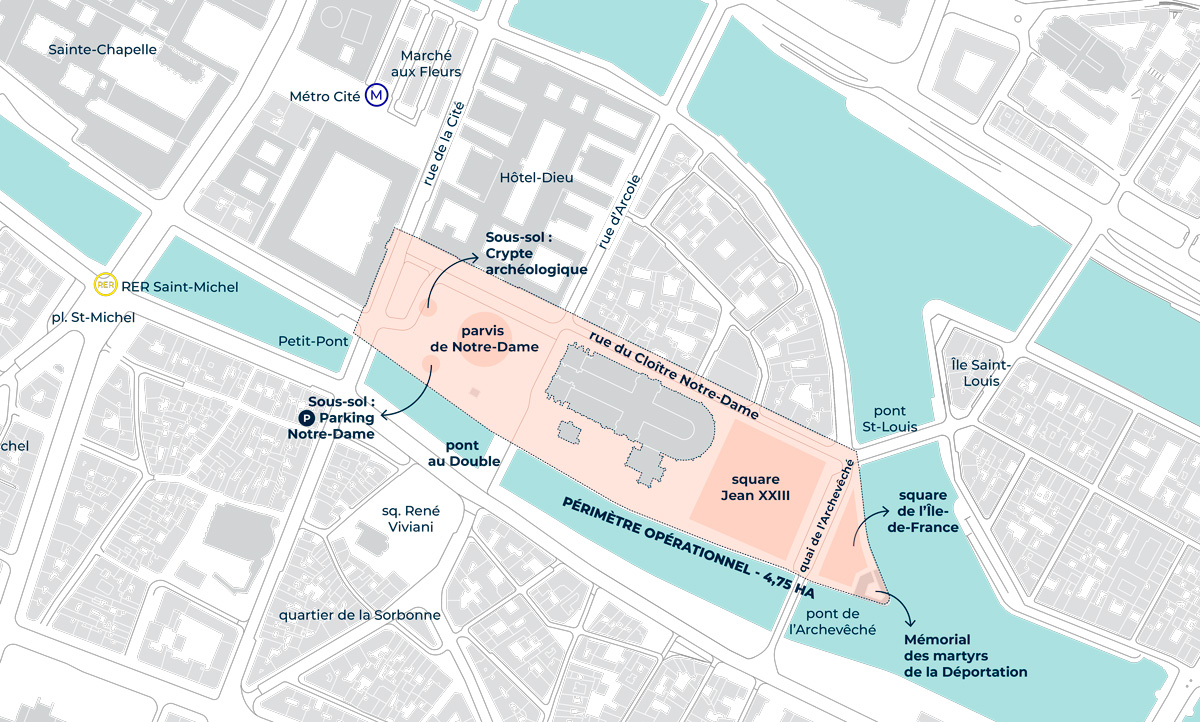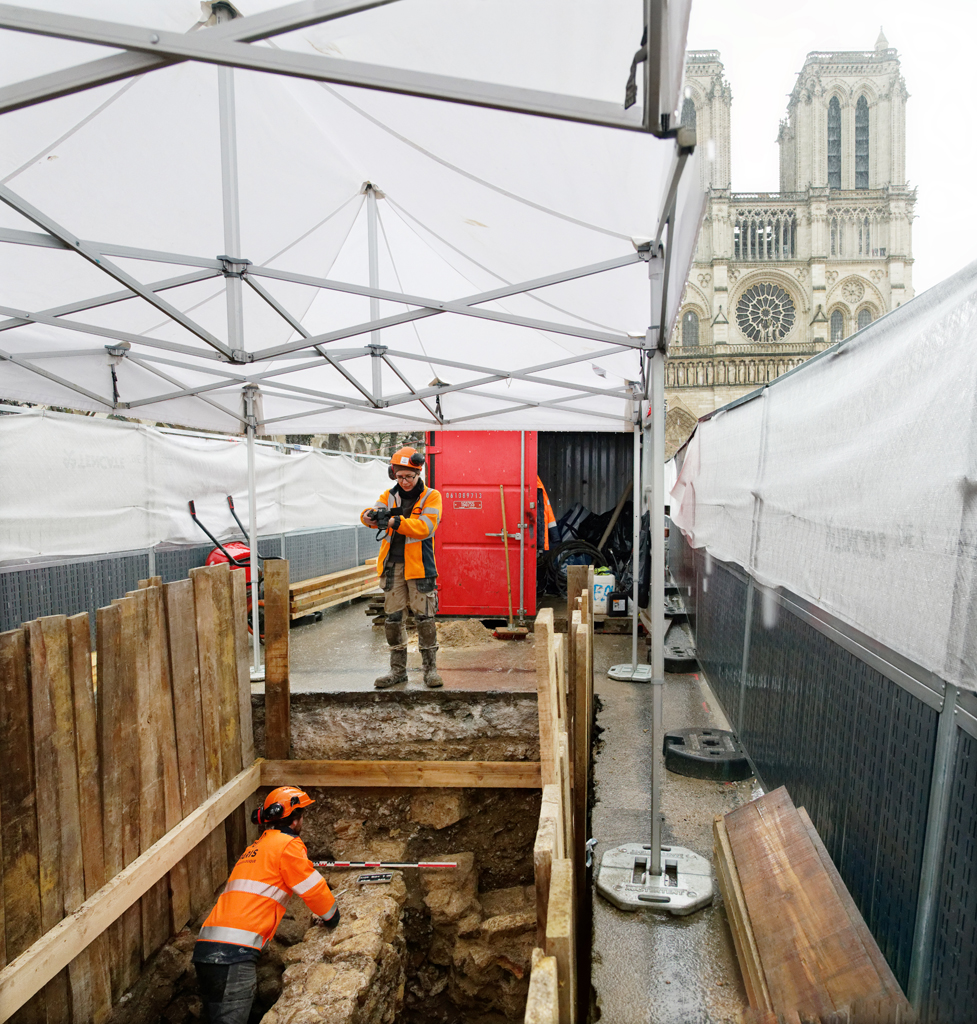Content
Cette page est aussi disponible en français
From autumn 2025, the area around the cathedral will be the focus of a first step towards its future redevelopment: preventive archaeological excavations. These will enable the redevelopment of the site to begin in early 2026.
The project, which combines environment and heritage, gives a large place to vegetation, improves thermal comfort for users and underlines the major perspectives of this emblematic site. The former underground parking lot, located beneath the forecourt, will become a reception area for the public. This interior promenade, open to the Seine and offering new views of the cathedral, will also be the new entrance to the archaeological crypt museum, and provide access to various amenities.
This project is the subject ofa deliberation voted by the Paris Council on April 15, 2021, two years after the terrible fire that ravaged the building. This redevelopment, carried out in close coordination with theÉtablissement public chargé de la conservation et de la restauration de la cathédrale Notre-Dame de Paris, will be mostly completed by 2028, according to the schedule for releasing the cathedral's restoration rights-of-way.
Rethinking the area around Notre-Dame is a question of public spaces for the city of tomorrow.
landscape architect
The winning project for the redevelopment of the cathedral's surroundings was announced in June 2022 by a jury chaired by the Mayor of Paris, with representatives from the Établissement public chargé de la conservation et de la restauration de la cathédrale Notre-Dame de Paris (EPRNDP) and the Diocese of Paris.
The team is led by landscape architect Bas Smets - with the GRAU architectural and urban planning firm, and, for the heritage component, the Neufville-Gayet architectural firm.
"For 800 years, Notre-Dame has been a privileged witness to the city's transformation. Rethinking its surroundings is first and foremost a question of public spaces for the city of tomorrow," explains Bas Smets, landscape architect. Urban features such as forecourts, squares, alignments and riverbanks are all present around the cathedral, but in fragmented form. The project reveals the quality of each place and rethinks each of these figures from the dual angle of the collective and the climate. "
The project in pictures
A forecourt designed as a clearing
The new forecourt is designed as a clearing, highlighting Notre-Dame's eastern facade in a green setting. The surrounding trees will provide shaded seating, while a thin 5-millimeter-high sheet of water will trickle down to cool the square in hot weather, creating ephemeral reflections.
At the tip, a calm and protected green space
The space behind the cathedral, as large as the forecourt in front, will become a large, continuous square between the chevet and the tip of the Ile de la Cité. It opens onto the buttresses and stained-glass windows, and highlights the Memorial to the Martyrs of the Deportation.
Another new feature: traffic on rue du Cloître-Notre-Dame and the Pont de l'Archevêché will be calmed and greened.
A 400-metre-long riverside park.
Crédit photo :
Studio Alma pour groupement Bureau Bas Smets
At the tip, a calm, unspoilt green space.
Crédit photo :
Studio Alma pour groupement Bureau Bas Smets
A large, continuous square runs between the chevet and the pointe l'Île, opening onto the buttresses and stained-glass windows.
Crédit photo :
Studio Alma pour groupement Bureau Bas Smets
The gardens to the south of the cathedral, along with the existing trees, will be integrated into a large 400-meter-long riverside park. A total of 160 new trees will be planted. The Notre-Dame site will be planted an additional 1,800m2 (+10%).
The former underground parking lot becomes a new reception area
Construction of the parking lot under the Notre-Dame forecourt in the 1960s.
Crédit photo :
Cité de l'Architecture
The underground parking lot is transformed into a visitor center, offering new access to the Archaeological Crypt, as well as amenities and a climate shelter for Parisians and visitors alike.
Crédit photo :
Olivier Campagne
The underground parking lot is transformed into a visitor center, offering new access to the Archaeological Crypt, as well as amenities and a climate shelter for Parisians and visitors alike.
Crédit photo :
Olivier Campagne
The underground parking lot is transformed into a visitor center, offering new access to the Archaeological Crypt, as well as amenities and a climate shelter for Parisians and visitors alike.
Crédit photo :
Olivier Campagne
The underground parking lot is transformed into a visitor center, offering new access to the Archaeological Crypt, amenities and a climate shelter for Parisians and visitors alike. An opening onto the Seine provides natural light, as well as an unparalleled panorama of the river and its banks.
4.7 hectares redeveloped
Conducted in close collaboration with the Etablissement public de conservation et de restauration de la cathédrale Notre-Dame de Paris (EPRND), which enabled the cathedral to be reopened to the public in December 2024, the project for the surroundings of Notre-Dame concerns not only the forecourt, but also its environment. It is part of the plan to revitalize the center of Paris through the pedestrian calming and "Embellir votre quartier" initiatives.
In concrete terms, the redevelopment will involve :
-
the forecourt and its underground areas, including the archaeological crypt and an ancient two-storey parking lot
-
squares Jean XXIII and de l'Île-de-France (behind the cathedral) to the tip of Ile de la Cité
-
the upper and lower quays of the Seine
-
adjacent streets (rue du Cloître-Notre-Dame, rue de la Cité, quai de l'Archevêché)
The project respects the buildings and landscapes of high heritage value surrounding the site, and in particular the "Paris, banks of the Seine " site , which has been on UNESCO's World Heritage List since 1991.
Notre-Dame is the centerpiece of this exceptional site. Its urban environment is marked by the construction of the major facilities of the Haussmann era, giving it a monumental dimension. Apart from the cathedral and the Conciergerie, only the Place Dauphine and the heart of the block between the Rue d'Arcole and the Rue du Cloître Notre-Dame have survived the massive demolitions of the 19th century. The Notre-Dame site is therefore not a homogeneous space, and has already undergone multiple transformations.
Archaeological digs, the first stage in the project
In the 1970s, excavations on the cathedral's forecourt uncovered the remains of ancient and medieval residential quarters, now on display in the Crypt Museum. At the time, these excavations had not covered the entire site. It is assumed that new traces will be discovered, flush with the pavement.
As part of the development project, the Pôle archéologique is currently carrying out preventive excavations to detect remains likely to be destroyed by the works.
View of the archaeological survey to be carried out in spring 2025 on the forecourt of Notre-Dame.
Crédit photo :
Marc Lelièvre/ DHAAP
The Pôle archéologique' s mission is to inventory, study, conserve and promote this exceptional heritage. It is also authorized to carry out archaeological diagnostics and excavations on Parisian territory.
The teams intervene :
-
upstream of the worksite, with the production of a scientific project defining the excavation perimeter;
-
on site, with stripping, which uses a mechanical shovel to access the deeper archaeological layers and the remains and artefacts that can be removed;
-
in the laboratory, with the cleaning, sorting, referencing and study of the objects discovered.
Each stage is documented (notes, drawings, photographs, topographical surveys, etc.) to enable archaeologists and experts to retrace the history of the site.
Some of the objects recovered during the works will be added to the museographical tour of the Notre-Dame de Paris archaeological crypt.
To know more
Following an initial meeting of the National Commission for Heritage and Architecture (CNPA) on the project's program, the commission met for a second time on May 11, 2024, and issued a favorable opinion on the project submitted by the Bas Mets team. >Learn more about the CNPA
On April 28, 2023, the Direction régionale et interdépartementale de l'environnement, de l'aménagement et des transports d'Île-de-France (DRIEAT) issued a favorable decision on the Notre-Dame redevelopment project, exempting the City of Paris from carrying out an environmental assessment.> Consult the decision
On April 28, 2023, the Direction régionale et interdépartementale de l'environnement, de l'aménagement et des transports d'Île-de-France (DRIEAT) issued a favorable decision on the Notre-Dame redevelopment project, exempting the City of Paris from carrying out an environmental assessment.> Consult the decision
Public consultation
From May to November 2021, a wide-ranging public consultation was held on the future of the Notre-Dame area. The aim is to involve as many people as possible in the project (site stakeholders, local residents and shopkeepers, Parisians, Greater Parisians, Ile-de-France residents and visitors).
What kind of financing?
This operation is financed by the City of Paris to the tune of 50 million euros.
Podcasts tell the story of Notre-Dame's surroundings
A series of podcasts lasting less than five minutes presents the views of experts, researchers, teachers and young people who have worked on the issues surrounding this exceptional site. What do the "surroundings" of Notre-Dame mean? How has the landscape evolved around the cathedral? How does the Diocese of Paris perceive these surroundings and their future development?
Keep up with Paris news
Every Friday, get all the latest Paris news delivered straight to your inbox. We'll tell you everything you need to know about the city's transportation, transformation, new projects and culture.
Default Confirmation Text
Settings Text Html
Settings Text Html
We want to hear from you!
Was this information useful to you?
Please note: we cannot reply via this form (please do not include any personal information).
